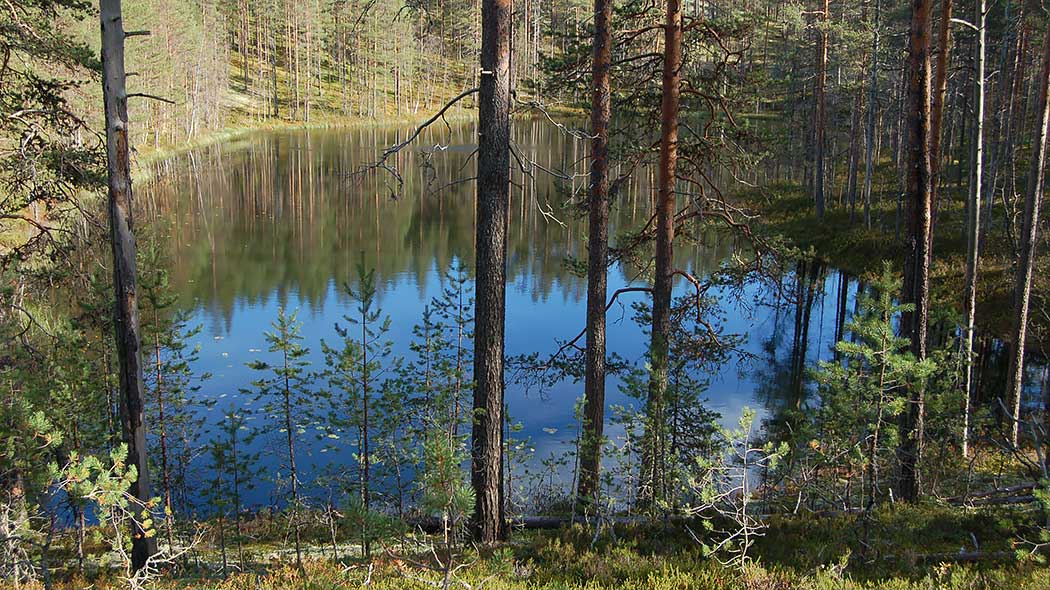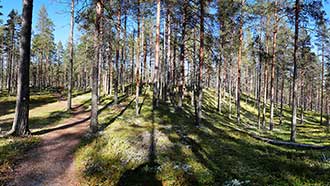Natural Features of Rokua National Park

Rokua UNESCO Global Geopark

Lying in the northern part of Ostrobothnia, Rokuanvaara Hill forms part of the 20 km long and 5 km wide esker and sand dune formation standing above a flat expanse of mires. Rokua is included in Natura 2000 network and Global Geoparks network. Rokua National Park, 9,9 sq.km, on the southern side of the Rokuanvaara hill was established in 1956.
Shaped by ice, wind and water, this landscape is a fragile one
The unique and diverse landscape of Rokua was formed as a consequence of Rokuanvaara Hill rising as an island out of the sea after the Ice Age. Formed mainly of sand, the island was then sculpted by water and wind. The sand dunes deposited by the wind are now, however, hidden under forests and other vegetation. Beach embankments, created by ice and waves, indicate the water level at various postglacial stages of the Baltic Sea. Steep-sided "suppa" kettle holes in the esker are marks of large blocks of ice, which got buried in the sand during the Ice Age. Syvyydenkaivo, "the Well of Depth", is the deepest hole formed this way in Finland. Kettle holes are typically the most wet places in the middle of eskers and in Syvyydenkaivo one can witness how rapidly the kettles dry upper parts changed to the wet bottom.

An indication of the fact, that erosion is still capable of moving the surface deposits in Rokua, are the areas of bare sand, where logging or feet of hikers have exposed the ground; on the slopes this can even cause small landslides.
Common redstart and pine in Rokua
Rugged pine woods do not have an abundance of bird species. The number of bird species found in the rugged pine woods is about one tenth of the number in more diverse and lush forests. Hikers can often spot the modestly coloured spotted flycatcher (Muscicapa striata), tree pipit (Anthus trivialis) or a willow tit (Poecile montanus). An orange and red male common redstart (Phoenicurus phoenicurus) stands out in this crowd due to its colour and its fancy song. The redstart’s song that has been described as slightly sorrowful can be heard on light early summer nights, from a high in the treetops, hidden from the gaze of people. Later in the summer, adult birds hunt for insects to feed their chicks, and can be spotted vibrating their tails on a tree stump or the lower branches of a tree. That’s when the species’ colour makings really stand out; their black and white head, grey back and red-brown tail. Their name is little misleading for a bird that loves in the light and airy, rugged pine woods. The name originates from an old word for blood, which still refers to the reddish tones of the black alder’s wood. Breeding and rearing chicks is an intense time for the redstart, especially for those who have an extra cuckoo's chick to raise. It takes double the effort and time to raise the adopted chick, which ends up being ten times as heavy as the redstart chicks, and not so fancy either.

Rokuanvaara, the kingdom of pines
Many visitors at Rokua will at some point during their trip start to wonder why only pine trees grow here. Where are the spruces, birches, aspens and other leafy trees? A sharp-eyed visitor can spot those types of trees on the wet shores of ponds, lakes and streams and on the edges of mires, but Rokuanvaara's extensive forests mainly consist of just pines.
Rokua has naturally been the kingdom of pines, but forest maintenance that has happened outside the National Park, and favours these types of trees, has probably played a part. The soil at Rokua is exceptionally fine, easily water-permeable sand. In this extremely dry and rough terrain, it is usually only pine trees that can survive.
Pines are also well adapted to the frequent forest fires that Rokua has had in the past centuries. The sturdy old pines branches are high up, away from the reach of the flames, and their trunk is protected by a thick armour of bark. Only a very strong forest fire can kill such a tree. A new generation of pine trees is quickly born from the seeds that survived the fire. Pine is considered a so-called ‘pioneer species’ whose seeds soon spread from to the area that was previously burned area.
Plenty of old tar pits can still be found in and around Rokuanvaara. The abundance of pines at Rokuanvaara is one of the main reasons for the prevalence of tar production in the area. It is also likely that the sandy soil, which can easily be dug into a tar pit, contributed to the industry. The Oulu River, which was the most bustling waterway in the region, is only 5 to 10km from Rokua. The tar was quickly transported along the Oulu River to Toppila Tervahovi in Oulu. From there it was exported overseas, where it was used, for example, to waterproof sailing ships.
Endless sand
The exceptionally high amount of sand in the area distinguishes Rokua dramatically from it's surroundings.

Carpets of lichen and sun-drenched esker ridges
Rokua's fauna and flora are of the typical barren forest kind with low biodiversity. The specialities of the set of the species in the area can be found on the slopes of the "suppa" holes, and on the steep southern hillsides parched by the sun. Several rare esker species grow there, such as the Creeping Thyme (Thymus serpyllum), the Shaggy Mouse-ear Hawkweed (Pilosella peleteriana), the Fragrant Solomon's Seal (Polygonatum odoratum) and the Rare Spring-Sedge (Carex ericetorum). Many threatened butterflies which feed on the Thyme and hymenopteran species, have been found in Rokua.

Reindeers have not been kept in the area for at least 150 years. Therefore the lichen on the barren sandy heath has grown uninterrupted. Today, in many places at Rokuanvaara Hill the ground is covered in bright white Reindeer Lichen (Cladina rangiferina, C. stellaris) in its natural state, which gives the landscape its unique appearance.
Rokua, one of the smallest National Park in Finland, has old-growth pine forests in their natural state, rare in the region, with lots of stout old trees, and dead standing, barkless trees.
Rokua National Park
- Established 1956
- Area 18 km²

The Emblem of Rokua National Park is Common Redstart.








